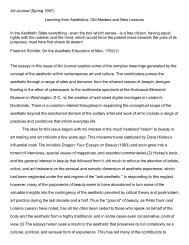Lessons in Futility: Francis Alÿs and the Legacy of ... - Grant Kester
Lessons in Futility: Francis Alÿs and the Legacy of ... - Grant Kester
Lessons in Futility: Francis Alÿs and the Legacy of ... - Grant Kester
You also want an ePaper? Increase the reach of your titles
YUMPU automatically turns print PDFs into web optimized ePapers that Google loves.
<strong>the</strong>ir situational orientation); necessarily preferable to those that are premised on<br />
a more coherent, stable, or collective sense <strong>of</strong> self. Here <strong>the</strong> problematic<br />
synchronic bias <strong>of</strong> poststructuralist <strong>the</strong>ory asserts itself, lead<strong>in</strong>g to a tendency to<br />
reify states <strong>of</strong> be<strong>in</strong>g. Identity is treated as ei<strong>the</strong>r static or fluid, coherent or<br />
<strong>in</strong>coherent, stable or de-stabilized, porous or impermeable, s<strong>in</strong>gular or collective.<br />
In each case ethical privilege is assigned to only one <strong>of</strong> two fixed positions (an<br />
entirely benign, ceaselessly chang<strong>in</strong>g, pre-subjective desire on <strong>the</strong> one h<strong>and</strong>,<br />
<strong>and</strong> a violent <strong>and</strong> objectify<strong>in</strong>g drive on <strong>the</strong> o<strong>the</strong>r), <strong>and</strong> only disruption <strong>and</strong><br />
fragmentation are seen as epistemologically productive.<br />
There is an implicit l<strong>in</strong>kage here between <strong>the</strong> fear <strong>of</strong> more direct forms <strong>of</strong><br />
social engagement <strong>in</strong> art <strong>and</strong> <strong>the</strong> erosion <strong>of</strong> authorial autonomy represented by<br />
collaborative or collective practices. The fear stems <strong>in</strong> each case from a concern<br />
that <strong>the</strong> specificity <strong>of</strong> art is under assault. In fact, <strong>the</strong> past decade has witnessed<br />
a remarkable proliferation <strong>of</strong> collaborative, collective, <strong>and</strong> transdiscipl<strong>in</strong>ary<br />
approaches to art mak<strong>in</strong>g. For some commentators this represents a threaten<strong>in</strong>g<br />
dissolution <strong>of</strong> art’s cultural status, <strong>and</strong> its privileged role as an agent <strong>of</strong> critique. I<br />
would describe it <strong>in</strong>stead as evidence <strong>of</strong> a paradigm shift with<strong>in</strong> <strong>the</strong> field <strong>of</strong> art,<br />
even as <strong>the</strong> nature <strong>of</strong> this shift <strong>in</strong>volves a re-articulation <strong>of</strong> aes<strong>the</strong>tic autonomy<br />
<strong>and</strong> an <strong>in</strong>creas<strong>in</strong>g permeability between art <strong>and</strong> o<strong>the</strong>r zones <strong>of</strong> symbolic<br />
production (plann<strong>in</strong>g, activism, social work, etc.). The grow<strong>in</strong>g <strong>in</strong>terest <strong>in</strong><br />
collaborative <strong>and</strong> collective practices has highlighted certa<strong>in</strong> disjunctions <strong>in</strong> <strong>the</strong><br />
dom<strong>in</strong>ant <strong>the</strong>oretical discourse <strong>of</strong> contemporary art. I will exam<strong>in</strong>e <strong>the</strong>se<br />
disjunctions <strong>in</strong> <strong>the</strong> follow<strong>in</strong>g essay, us<strong>in</strong>g a project by <strong>the</strong> Belgian artist <strong>Francis</strong><br />
4




